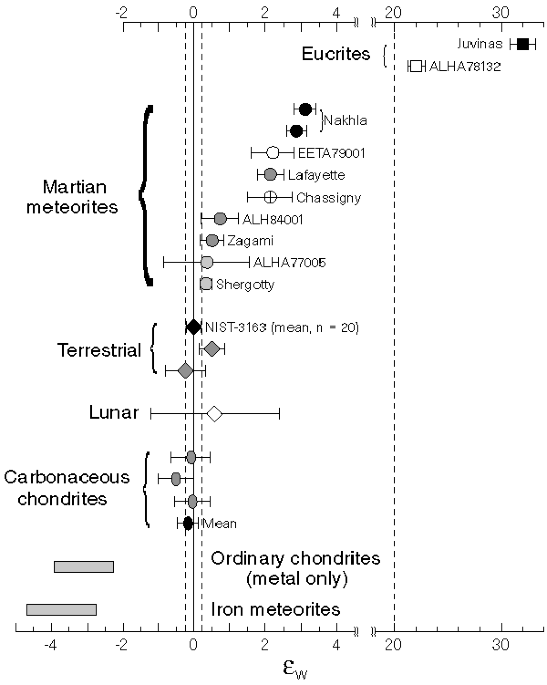
- Select a language for the TTS:
- UK English Female
- UK English Male
- US English Female
- US English Male
- Australian Female
- Australian Male
- Language selected: (auto detect) - EN
Play all audios:
ABSTRACT Meteorite chronometry based on the 182Hf–182W system can provide powerful constraints on the timing of planetary accretion and differentiation1,2,3,4, although the full potential of
this method has yet to be realized. For example, no measurements have been made on the silicate-rich portions of planets and planetesimals other than the Earth and Moon. Here we report
tungsten isotope compositions for two eucrites, thought to be derived from asteroid 4 Vesta, and from eight other basaltic achondritic meteorites that are widely considered to be from Mars.
The eucrites, which are among the oldest differentiated meteorites, yield exceedingly radiogenic tungsten, indicating rapid accretion, differentiation and core formation on Vesta within the
first 5–15 Myr of Solar System history, whereas the range of radiogenic tungsten measurements on the martian meteorites points towards tungsten depletion via melting and core formation
within the first 30 Myr of the Solar System. The survival of tungsten isotope heterogeneity in the martian upper mantle implies that no giant impacts or large-scale convective mixing took
place since this time. These results contrast with those obtained for the Earth–Moon system2,3 for which accretion and core formation related to giant impacts appears to have continued for
at least an additional 20 Myr. Access through your institution Buy or subscribe This is a preview of subscription content, access via your institution ACCESS OPTIONS Access through your
institution Subscribe to this journal Receive 51 print issues and online access $199.00 per year only $3.90 per issue Learn more Buy this article * Purchase on SpringerLink * Instant access
to full article PDF Buy now Prices may be subject to local taxes which are calculated during checkout ADDITIONAL ACCESS OPTIONS: * Log in * Learn about institutional subscriptions * Read our
FAQs * Contact customer support SIMILAR CONTENT BEING VIEWED BY OTHERS PARTIAL DIFFERENTIATION OF EUROPA AND IMPLICATIONS FOR THE ORIGIN OF MATERIALS IN THE JUPITER SYSTEM Article 27
January 2025 EARLY SILICIC MAGMATISM ON A DIFFERENTIATED ASTEROID Article 04 August 2022 METEORITIC EVIDENCE FOR A CERES-SIZED WATER-RICH CARBONACEOUS CHONDRITE PARENT ASTEROID Article 21
December 2020 REFERENCES * Harper, C. L. & Jacobsen, S. B. Evidence for 182Hf in the early Solar System and constraints on the timescale of terrestrial accretion and core formation.
_Geochim. Cosmochim. Acta_ 60, 1131–1153 (1996). Google Scholar * Lee, D. -C. & Halliday, A. N. Hafnium–tungsten chronometry and the timing of terrestrial core formation. _Nature_ 378,
771–774 (1995). Article ADS CAS Google Scholar * Halliday, A. N., Rehkämper, M., Lee, D. -C. & Yi, W. Early evolution of the Earth and Moon: new constraints from Hf–W isotope
geochemistry. _Earth Planet. Sci. Lett._ 142, 75–89 (1996). Google Scholar * Lee, D. -C. & Halliday, A. N. Hf–W isotopic evidence for rapid accretion and differentiation in the early
solar system. _Science_ 274, 1876–1879 (1996). Google Scholar * Righter, K. & Drake, M. J. Core formation in Earth's Moon, Mars and Vesta. _Icarus_ 124, 513–529 (1996). Google
Scholar * Wänke, H. & Dreibus, G. Chemical composition and accretion history of terrestrial planets. _Phil. Trans. R. Soc. Lond. A_ 325, 545–557 (1988). Google Scholar * Binzel, R. P.
& Xu, S. Chips off of asteroid 4 Vesta: evidence for the parent body of basaltic achondrite meteorites. _Science_ 260, 186–191 (1993). Google Scholar * Shukolyukov, A. & Lugmair, G.
W. 60Fe in eucrites. _Earth Planet. Sci. Lett._ 119, 159–166 (1993). Google Scholar * Lugmair, G. W. & MacIsaac, Ch. Radial heterogeneity of 53Mn in the early solar system? _Lunar
Planet. Sci._ XXVI, 879–880 (1995). Google Scholar * Lugmair, G. W. & Shukolyukov, A. 53Mn–53Cr isotope systematics of the HED parent body. _Lunar Planet. Sci._ XXVIII, 651–852 (1997).
Google Scholar * Shukolyukov, A. & Begemann, F. Pu–Xe dating of eucrites. _Geochim. Cosmochim. Acta_ 60, 2453–2471 (1996). Google Scholar * Newsom, H. E., White, W. M., Jochum, K. P.
& Hofmann, A. W. Siderophile and chalcophile element abundances in oceanic basalts, Pb isotope evolution and growth of the earth's core. _Earth Planet. Sci. Lett._ 88, 299–313
(1986). Google Scholar * Lugmair, G. W. & Galer, S. J. G. Age and isotopic relationships among the angrites Lewis Cliff 86010 and Angra dos Reis. _Geochim. Cosmochim. Acta_ 56,
1673–1694 (1992). Google Scholar * Göpel, C., Manhès, G. & Allègre, C. J. Constraints on the time of accretion and thermal evolution of chondrite parent bodies by precise U–Pb dating of
phosphates. _Meteorites_ 26, 73 (1991). Google Scholar * McSween, H. Y. What we have learned about Mars from SNC meteorites. _Meteoritics_ 29, 757–779 (1994). Google Scholar * Jagoutz,
E., Sorowka, A., Vogel, J. D. & Wänke, H. ALH84001: alien or progenitor of the SNC family? _Meteoritics_ 9, 478–479 (1994). Google Scholar * Nakamura, N., Unruh, D. M. & Tatsumoto,
M. Origin and evolution of the Nakhla meteorite inferred from the Sm–Nd and U–Pb systematics and REE, Ba, Sr, Rb and K abundances. _Geochim. Cosmochim. Acta_ 46, 1555–1573 (1982). Google
Scholar * Shih, C. -Y._et al_. Chronology and petrogenesis of young achondrites, Shergotty, Zagami, and ALHA77005: late magmatism on a geologically active planet. _Geochim. Cosmochim. Acta_
46, 2323–2344 (1982). Google Scholar * Chen, J. H. & Wasserburg, G. J. Formation ages and evolution of Shergotty and its parent planet from U–Th–Pb systematics. _Geochim. Cosmochim.
Acta_ 50, 955–968 (1986). Google Scholar * Jagoutz, E. & Wänke, H. Sr and Nd isotopic systematics of Shergotty meteorites. _Geochim. Cosmochim. Acta_ 50, 939–953 (1986). Google Scholar
* Treiman, A. H._et al_. Core formation in the Earth and shergottite parent body (SPB): chemical evidence from basalts. _Geochim. Cosmochim. Acta_ 50, 1071–1091 (1986). Google Scholar *
Harper, C. L._et al_. Rapid accretion and early differentiation of Mars indicated by 142Nd/144Nd in SNC meteorites. _Science_ 267, 213–217 (1995). Google Scholar * Stevenson, D. J. in
_Origin of the Earth_(eds Newsom, H. E. & Jones, J. H.) 231–249 (Oxford Univ. Press, London, (1990)). Google Scholar * Sleep, N. H. Martian plate tectonics. _J. Geophys. Res._ 99,
5639–5655 (1994). Google Scholar * Breuer, D., Spohn, T. & Wüllner, U. Mantle differentiation and the crustal dichotomy of Mars. _Planet. Space Sci._ 41, 269–283 (1993). Google Scholar
* Breuer, D., Yuen, D. A. & Spohn, T. Phase transitions in the Martian mantle: implications for partially layered convection. _Earth Planet. Sci. Lett._ 148, 457–469 (1997). Google
Scholar * Bertka, C. M. & Fei, Y. Mineralogy of the Martian interior up to core-mantle boundary pressures. _J. Geophys. Res._ 102, 5251–5264 (1997). Google Scholar * Harder, H. &
Christensen, U. R. Aone-plume model of martian mantle convection. _Nature_ 380, 507–509 (1996). Article ADS CAS Google Scholar * Salters, V. J. M. & Hart, S. R. The mantle sources of
ocean ridges, islands and arcs: the Hf-isotope connection. _Earth Planet. Sci. Lett._ 104, 364–380 (1994). Google Scholar * Lee, D. -C. & Halliday, A. N. Precise determinations of the
isotopic compositions and atomic weights of molybednum, tellurium, tin and tungsten using ICP magnetic sector multiple collector mass spectrometry. _Int. J. Mass Spec. Ion Proc._ 146/147,
35–46 (1995). Google Scholar Download references ACKNOWLEDGEMENTS We thank M. Lindstrom, L. Nyquist, G. MacPherson, C. Perron and M. Wadhwa for access to their meteorite collections at
NASA, Smithsonian Institution of Washington, Museum National d'Histoire Naturelle at Paris, and Field Museum in Chicago. We also thank J. Christensen, E. Essene, H. Pollack, M.
Rehkämper, P. van Keken and Y. Zhang for their comments, M. Johnson and C. Hall for their assistance, and K. Righter and M. Drake for access to unpublished papers. This work was supported by
NSF, DOE, NASA and the University of Michigan. AUTHOR INFORMATION AUTHORS AND AFFILIATIONS * Department of Geological Sciences, University of Michigan, Ann Arbor, 48109-1063, Michigan, USA
Der-Chuen Lee & Alex N. Halliday Authors * Der-Chuen Lee View author publications You can also search for this author inPubMed Google Scholar * Alex N. Halliday View author publications
You can also search for this author inPubMed Google Scholar CORRESPONDING AUTHOR Correspondence to Der-Chuen Lee. RIGHTS AND PERMISSIONS Reprints and permissions ABOUT THIS ARTICLE CITE THIS
ARTICLE Lee, DC., Halliday, A. Core formation on Mars and differentiated asteroids. _Nature_ 388, 854–857 (1997). https://doi.org/10.1038/42206 Download citation * Received: 03 April 1997 *
Accepted: 15 July 1997 * Issue Date: 28 August 1997 * DOI: https://doi.org/10.1038/42206 SHARE THIS ARTICLE Anyone you share the following link with will be able to read this content: Get
shareable link Sorry, a shareable link is not currently available for this article. Copy to clipboard Provided by the Springer Nature SharedIt content-sharing initiative





